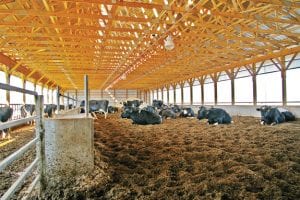A panel of farmers who have used bedded packs were featured at the NY Certified Organic (NYCO) meeting on January 8, 2019, in Jordan Hall, 630 West North Street, Cornell AgriTech, Geneva, NY. NYCO Winter Meeting Organizer and CCE Small Dairy Specialist Fay Benson provided information on the two types of bedded pack systems, including some pros and cons of each type, and examples of one system in Vermont and one in New York.
Vermont Pack Barn Shows Innovation
Bedded pack barns have been used in Vermont as a way for a smaller operation to build manure storage since the state prohibited winter spreading of manure in 1995. At his organic Butterworks Farm in Westfield, Jack Lazor used a DBP with three animal groups in a 60X120-foot barn. He separated them with electric fences suspended from the ceiling and raised as the pack grew. A 6-foot coil of water line inside water troughs unwound as the waterers rose with the pack. Jack used bale rings to feed baleage on the pack.
Jack noted that the return for the significant expense of straw for the pack ($40-$45 every other day plus the labor of composting the pack), was a positive effect on the soil and soil nutrients. Once the cows went out to pasture, Jack would usually remove the pack after first cutting. He left it in long, 6-foot-high windrows on a nearby field until after the last harvest. By leaving it for 3 months, the pack composted to reduce the amount to haul to fields for spreading. Jack reasoned that applying the aged manure in the fall mimicked nature applying carbon to the soil in the fall with dead leaves and grass.
“Raw manure is hard on the soil and the environment; many of the nutrients are volatile or water soluble. By adding the extra carbon through the straw more of the volatile nutrients are captured and stored. Allowing them to go through the biological activity of composting, the nutrients are stabilized and won’t run off with significant rainfalls,” Jack said.
NY Farm Adds Pack Barn, Then Free Stalls
In 2010, Super Milk producers Ben and Kate Whittemore of Dead End Farm, an 80-cow organic dairy in Candor, NY, built a 70×120-foot bedded pack barn with a 16-foot feed alley and 16-foot scrape alley.
“Our cows loved the bedded pack barn with its thick, cushy bedding and wide open space to kick up their heels,” Kate Whittemore wrote in her farm blog, noting that most of the cows chose the bedded pack at night over the pasture.
The Whittemores first used chopped hay in the pack since it was less expensive, but found it more labor-intensive and not as dry. They switched to sawdust as easier to apply and easier to stir with their rotovator. Stirring three times a day improved the composting efficiency, and they were able to go more than a year between barn cleanouts.
The Whittemores decided to add more animals, and felt the best way to expand was to replace the bedded pack with free stalls. In 2014, they increased 85 to 120 milkers in the same barn.
The Benefits of a Bedded Pack Barn
- Increases cow comfort
- Can increase milk production
- Manure storage with less capital investment and less labor requirement than liquid storage
- Pack manure mixed with extra carbon is a better soil nutrient then raw manure from typical manure storage
- Particularly adapted to grazing dairies since barns are used only 6 months and allow plenty of time to clean
- An option for out-dated dairies looking for build a combined housing-feeding barn with manure storage
- Enhances dairy farm conservation practices

